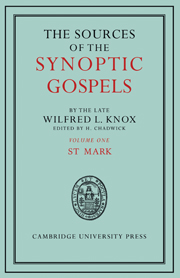Book contents
- Frontmatter
- Dedication
- Contents
- EDITOR'S PREFACE
- PREFACE
- ABBREVIATIONS
- INTRODUCTION
- I The first group of conflict-stories
- II The Twelve-source
- III Jesus and the devils
- IV The book of parables
- V Books of miracles
- VI Nazareth and John the Baptist
- VII Corban and miscellaneous incidents
- VIII A book of localized miracles
- IX The ‘Central Section’
- X The entry to Jerusalem
- XI A second group of conflict-stories?
- XII The warning against the scribes
- XIII The ‘Little Apocalypse’
- XIV The Passion story
- XV The Resurrection story
- SUMMARY
- INDEXES
VII - Corban and miscellaneous incidents
Published online by Cambridge University Press: 05 July 2014
- Frontmatter
- Dedication
- Contents
- EDITOR'S PREFACE
- PREFACE
- ABBREVIATIONS
- INTRODUCTION
- I The first group of conflict-stories
- II The Twelve-source
- III Jesus and the devils
- IV The book of parables
- V Books of miracles
- VI Nazareth and John the Baptist
- VII Corban and miscellaneous incidents
- VIII A book of localized miracles
- IX The ‘Central Section’
- X The entry to Jerusalem
- XI A second group of conflict-stories?
- XII The warning against the scribes
- XIII The ‘Little Apocalypse’
- XIV The Passion story
- XV The Resurrection story
- SUMMARY
- INDEXES
Summary
The next section is a well-marked unit (vii. 1—23). It may have some foundations in history, in so far as Jesus may have used the testimonium of Isa. xxix. 13 against the Jews, though not in the LXX form (as in Mark vii. 6), nor on this occasion; more probably it is simply a proof-text used by the Gentile Church against the Jews in which the Pharisaic teaching as to vows is used, and perhaps distorted, as an argument against Judaism. It is possible indeed that Jesus did at some time use the argument from this practice against the Pharisees, but the last clause of 13 is quite clearly addressed by the Church to the synagogue. The introductory explanation of the standpoint of the Pharisees (which the reader has been assumed to understand at ii. 16, 23 and iii. 6) shows that we are dealing with a tract of Gentile origin, as does the typically hellenistic catalogue of vices at 18 ff.; the saying of 15 may, however, quite well be authentic. The whole section stands out as a well-marked unit. It is worth noting the structure, since we shall find similarly constructed tracts in dealing with St Luke. We have:
(1) A narrative introduction (expanded by an explanation of the practice of the Pharisees).
(2) A question addressed to Jesus.
(3) His answer.
(4) Further sayings introduced by ‘and he said unto them’.
- Type
- Chapter
- Information
- The Sources of the Synoptic Gospels , pp. 52 - 58Publisher: Cambridge University PressPrint publication year: 2011

